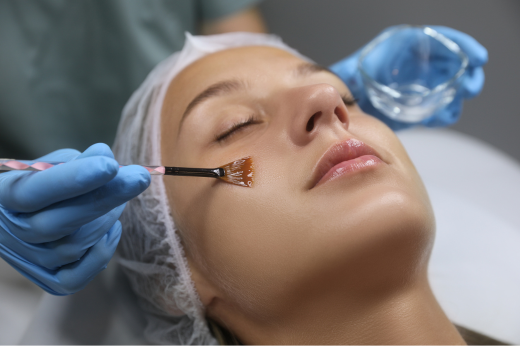
Having a young, radiant, and spotless skin is every woman's desire. The secret to beautiful skin is a healthy skincare regime. Over the past decades, many cosmetic treatments have evolved that have proven effective in revealing a radiant and spotless complexion. This article will highlight a revolutionary aesthetic procedure- "Chemical peels." If you are struggling with skin imperfections like hyperpigmentation, acne scars, or uneven skin tone, chemical peels are your ultimate solution. A chemical peel uses a chemical solution to remove your skin's top (superficial) layers, revealing clearer, youthful skin underneath. It is generally performed by a certified, well-trained dermatologist (a doctor specializing in diagnosing and treating conditions related to the skin, hair, and nails) in a clinical setup.
Keep scrolling to learn more about this excellent procedure and its mechanism.
Chemical peels, also known as "chemexfoliation" or "derma peeling," is a non-surgical, minimally invasive (does not require any injections or cuts) cosmetic procedure. The treatment involves using specially formulated, medically concentrated chemical solutions to remove the damaged, superficial (top) layer of your skin. This superficial layer eventually peels off, revealing a fresher, healthier, glowing skin with reduced wrinkles, pigmentation, and age spots. A chemical peel is one of the most cost-effective procedures to improve the appearance of your skin. The potential result of the chemical peel depends on the type of chemical solution, the type of skin imperfection to correct, the technique used, and the number of sessions.
Dermatologists often recommend chemical peels to fight signs of aging and discoloration of the skin. Chemical peels are most commonly performed on your face, neck, and hands.
It can help reduce or improve:
Your skin is the largest organ in your body that helps protect and shield it from dust, allergens, and harmful sun rays. As you age, your skin cells eventually lose collagen (a protein produced by your body, which plays an essential role in the structure and function of the skin, cartilage, bone, and connective tissue) and its protective barrier, resulting in damage and signs of aging. Chemical peels are one of the most effective, non-invasive cosmetic facial treatments. They give you flawless, brighter, youthful, spotless skin. Normally, our skin has a pH (Potential of Hydrogen, which measures how acidic or basic a substance or solution is) of around 5.5. The acids used during the chemical peels increase the skin's acidity to a 3.8 pH level.
The change in the pH level chemically loosens the cells that form the "glue" between the dead skin and healthy skin. This exfoliates the targeted layer of the skin due to the removal of the dead skin and reveals the underlying healthy skin. This stimulates new epidermal growth and collagen production with more evenly distributed melanin (a substance in your body that is responsible for hair, eye, and skin pigmentation) for the growth of new, healthy skin cells. Chemical peels are worth a try to rejuvenate and revitalize your dull, pigmented skin!!!
Choosing chemical peels depends on your skin type, complexion, and the issue being addressed. There are three types of chemical peels based on how deeply they exfoliate:
Chemical peels are safe and non-invasive, painless skin rejuvenation treatments. Yet, you may need to prepare yourself before the procedure for maximum comfort and optimal results.
Your dermatologist will:
Chemical peels are usually a safe, painless, and an outpatient (does not require hospitalization) procedure performed by a dermatologist.
For optimal results and minimum post-procedure complications, your dermatologist will instruct you to follow specific guidelines. These include:
Chemical peels are an effective, painless, and non-invasive means of reversing sun damage and the signs of aging. They treat acne scars and improve the overall appearance of your skin. Although it is possible to perform a chemical peel at home, this carries a greater risk of damaging your skin. Consult your dermatologist if you are concerned about aging skin for a revitalized look to boost your confidence.